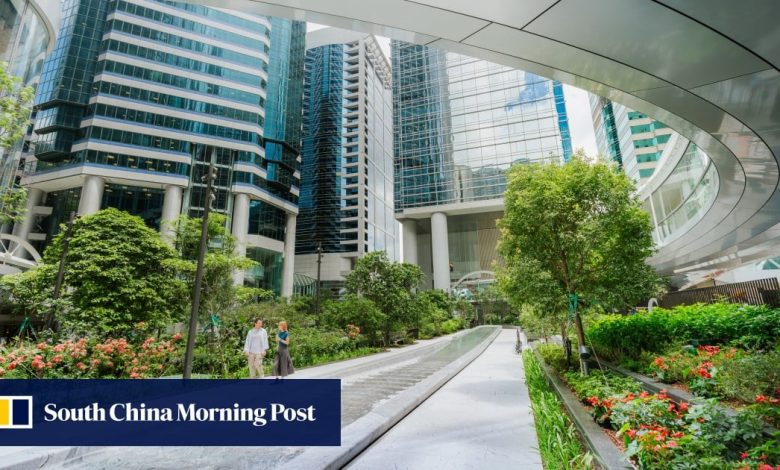Biophilic design at the heart of developer’s biodiversity strategy

Scientists have long known that any attempts to reverse the damage to natural ecosystems can only be achieved by sustainable and equitable development. The Biodiversity Plan, a result of the Kunming-Montreal Global Biodiversity Framework agreed by G7 countries in 2022 to reverse biodiversity loss by 2030, aims to mobilise at least US$30 billion each year from developed countries by 2030. These funds will be allocated to key areas including conservation efforts, ecosystem restoration and financial support for developing countries, with the aim of halting and reversing biodiversity loss and ensuring a sustainable and equitable future for all.

Biodiversity is at the forefront of Swire Properties’ SD 2030 Strategy, through which it aims to enrich natural ecosystems in urban neighbourhoods, leading to more resilient communities for residents and businesses. The strategy prescribes the conducting of biodiversity surveys across its new development projects and implementing guidelines to integrate biodiversity considerations in new developments by 2025. This follows the launch of Swire Properties’ biodiversity policy in 2019 and the completion last year of its biodiversity guidelines for Hong Kong to help the company’s project teams and management offices integrate biodiversity into its operations.
“Healthy ecosystems are fundamental to the success of our business operations,” says Don Taylor, director, office, Swire Properties. “Given the escalating challenges of environmental degradation, biodiversity loss and climate change, it is crucial for us to consider nature both in our building design and operations to create sustainable, future-proof developments that foster vibrant and resilient communities.”
The final part of the Taikoo Place redevelopment – which has transformed three industrial towers into the grade A office towers One Taikoo Place and Two Taikoo Place – sees the opening of two outdoor spaces, Taikoo Square and Taikoo Garden. The gardens demonstrate the way Swire Properties assesses and incorporates biodiversity considerations into the master plan of its properties.
“Since inception, Taikoo Square has been a core part of the Taikoo Place redevelopment master plan, and we had a vision for urban biodiversity starting from the design and planning stage. This project showcases our commitment to incorporating nature into our property design and operations,” Taylor says.

Swire Properties worked with award-winning landscape architectural practice Gustafson Porter + Bowman to design the gardens and water features, which take inspiration from Hong Kong’s mix of dense urban development and lush greenery, as well as the history of the site, which was once occupied by the Taikoo Dockyard.
The gardens have added about 70,000 sq ft of green space to Taikoo Place, with 30 per cent of the site now green. It is hoped the gardens will also improve the area’s microclimate, increase rainwater retention and improve air quality.
Vertical layering of native vegetation, greenery, trees and shrubs are intended to mimic a natural environment, providing wildlife with more cover and feeding opportunities. The gardens also form a green corridor for wildlife connecting to nearby Mount Parker and Quarry Bay Park.
Swire Properties partnered with ecological expert Dr Billy Hau, a lecturer at the School of Biological Sciences at the University of Hong Kong, to conduct a biodiversity study of Taikoo Place in the Quarry Bay area in 2020, exploring ways to improve the area’s ecological value.

The study inspired the developer to select more than 260 native and exotic plant species, drawing inspiration from Hong Kong’s feng shui woodlands – biodiversity hotspots in Hong Kong where villagers traditionally preserved native plant species and created habitats for wildlife.
Five species, including the incense tree – thought to have given Hong Kong the name “Fragrant Harbour” and threatened by poachers for its scented wood and resin – as well as the hog plum and fleshy nut tree, were grown from seedlings over several years at Kadoorie Farm and Botanic Garden before being transplanted to Taikoo Square.
By introducing a higher than average ratio of native to non-native plant species (more than 20 per cent) compared with other urban areas in Hong Kong, the company aims to cultivate a richer diversity of plants at Taikoo Square and Taikoo Garden.
Swire Properties says the integration of nature-based solutions at Taikoo Place marks the next stage of its commitment towards its sustainability goals.

“The Taikoo Place redevelopment is more than just a project; it is a demonstration of our dedication to building vibrant and sustainable communities that benefit both people and nature,” Taylor says. “Biodiversity is the next frontier in sustainable development, and Taikoo Place is setting an important precedent for future developments as we advance our efforts in this critical area.”


 Play with Welcome Bonus Up to 300%
Play with Welcome Bonus Up to 300%